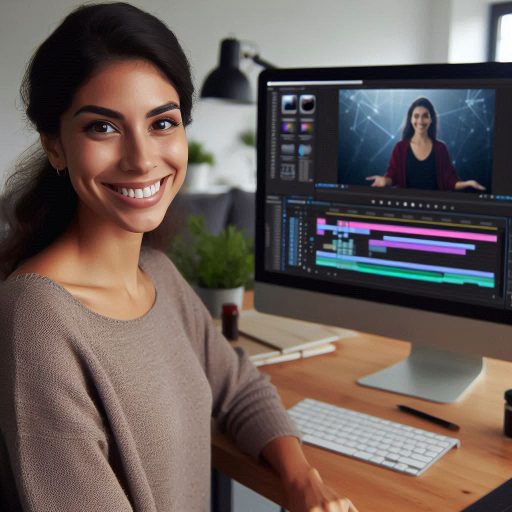Introduction
Digital art has emerged as a prominent form of expression, blending technology and creativity.
In 2024, the landscape of digital art is poised to undergo significant transformations that will shape the way artists create and interact with their audience.
Staying updated on digital art trends is crucial for artists and enthusiasts alike, as it allows them to stay relevant in a rapidly evolving field.
By keeping abreast of the latest developments, creators can harness new tools and techniques to push the boundaries of their art.
Key Trends to Watch
As we look ahead to 2024, several key trends are expected to dominate the digital art scene.
From the rise of NFTs and blockchain technology to the integration of artificial intelligence in art creation, these trends will revolutionize how art is conceived, produced, and consumed.
AR and VR Integration
Increasing Use of AR and VR
One of the key trends to watch in digital art in 2024 is the increasing use of augmented reality (AR) and virtual reality (VR) technologies.
These technologies gain traction in the art world.
Artists push creativity boundaries with these tools. They engage audiences innovatively and effectively.
Artists Incorporating AR and VR
Artists across various disciplines are incorporating AR and VR technologies into their work, blurring the lines between the physical and digital worlds.
Creatives use interactive installations and augmented reality in art.
They craft dynamic, immersive experiences that captivate viewers.
Evolution of AR and VR Integration
In 2024 and beyond, we can expect to see AR and VR integration continue to evolve and expand in the digital art space.
As technology advances, artists gain new opportunities for AR and VR.
They will experiment more with these technologies.
This leads to groundbreaking and boundary-pushing works of art.
Read: Networking Tips for Digital Artists
NFTs and Crypto Art
Non-fungible tokens (NFTs) and crypto art have been making waves in the art world, revolutionizing how digital art is bought, sold, and collected.
The Rise of NFTs and Crypto Art
NFTs are unique digital assets that are verifiable on the blockchain.
Crypto art refers to digital artworks that are tokenized as NFTs.
Transform Your Career Today
Unlock a personalized career strategy that drives real results. Get tailored advice and a roadmap designed just for you.
Start NowThe rise of NFTs has democratized the art world by providing artists with a new platform to showcase and sell their work.
Crypto art allows artists to tokenize their work, thereby proving ownership and authenticity.
Art collectors are now able to purchase digital artworks as NFTs, adding them to their collections.
Impact of NFTs on the Digital Art Market
NFTs have disrupted the traditional art market by creating a new digital marketplace.
Artists can now directly sell their work to collectors without the need for intermediaries.
NFTs have brought a new level of transparency and traceability to the art market.
The value of digital art has increased with the rise of NFTs, as scarcity and provenance are now verifiable.
Established and emerging artists alike have found success in the NFT space, reaching a global audience.
Potential Future of NFTs and Crypto Art in 2024
In 2024, NFTs and crypto art are likely to continue to grow in popularity.
More traditional artists may embrace the digital art world by tokenizing their work as NFTs.
Major art institutions and galleries may begin to incorporate NFTs and crypto art into their collections.
New platforms and marketplaces dedicated to NFTs and crypto art could emerge, expanding the ecosystem.
Regulations surrounding NFTs and crypto art may evolve to protect artists and collectors in the digital realm.
Overall, NFTs and crypto art are here to stay, reshaping the art world and providing new opportunities for artists and collectors alike.
The future of digital art in 2024 looks promising, with continued innovation and growth in the NFT space.
Read: Building a Character Design Portfolio from Scratch
AI Art
Artificial intelligence (AI) is revolutionizing the world of digital art, with more and more artists turning to AI algorithms to create stunning pieces.
Let’s explore this growing trend and see what advancements we can expect in AI art by 2024.
AI in Digital Art
AI opens new possibilities for artists. They experiment with unimaginable styles and techniques.
AI algorithms help artists create unique patterns and colors.
Transform Your Career Today
Unlock a personalized career strategy that drives real results. Get tailored advice and a roadmap designed just for you.
Start NowThey push the boundaries of traditional art forms.
Enhancing the Creative Process
AI algorithms can assist artists in brainstorming ideas, providing inspiration, and generating initial sketches.
This technology can help artists overcome creative blocks and explore new concepts, ultimately leading to more innovative and experimental artworks.
Predicted Advancements
In 2024, AI art will see significant advancements.
Algorithms will create highly detailed, intricate pieces.
Artists push AI technology limits, crafting interactive art.
They create immersive experiences, blending human creativity with artificial intelligence.
Read: How to Market Yourself as a Digital Artist

Sustainability in Digital Art
Artists actively embrace sustainability in the digital art industry.
They recognize the importance of eco-friendly practices in their work.
As we look ahead to 2024, several trends focused on sustainability are expected to continue shaping the landscape of digital art.
Importance of Sustainability in Digital Art
- Reducing environmental impact: Digital art, like all forms of technology, has a carbon footprint that contributes to climate change.
By adopting sustainable practices, artists can minimize this impact. - Promoting social responsibility: As awareness of environmental issues grows, consumers are becoming more conscious of the ethical implications of their purchasing decisions.
Artists who prioritize sustainability can appeal to this socially responsible audience. - Preserving resources for future generations: By embracing sustainable practices, digital artists can help ensure that valuable resources are not depleted, allowing future generations to continue creating and enjoying art.
Artists Incorporating Eco-Friendly Practices
- Using recycled materials: Some digital artists are repurposing electronic waste or other recyclable materials in their work, giving new life to discarded items and reducing waste.
- Minimizing energy consumption: Artists can reduce their environmental impact by optimizing their workflow to minimize energy usage, such as by using energy-efficient devices and software.
- Offsetting carbon emissions: To mitigate the environmental impact of their work, some artists are investing in carbon offset programs or supporting renewable energy initiatives.
Trends Towards Sustainability in 2024
- Collaborations with environmental organizations: Digital artists may increasingly partner with environmental nonprofits or advocacy groups to raise awareness of sustainability issues through their work.
- Virtual exhibitions and installations: With the rise of virtual reality and digital galleries, artists can showcase their eco-friendly art without the need for physical materials or venues, reducing their carbon footprint.
- Eco-conscious art marketplaces: Platforms that prioritize sustainability, such as offering eco-friendly printing options or supporting carbon offsetting, are likely to gain traction among environmentally conscious artists and collectors.
Read: Character Design for Animation: Key Considerations
Collaborative and Community Art Projects
Collaborative and community-based art projects have been gaining popularity in the digital art world in recent years.
Artists are coming together to create impactful works that go beyond individual efforts.
Highlight of the Trend
Collaborative art projects involve artists working together on a single piece or a series of works.
Community art projects engage the public in creating art, fostering a sense of unity and belonging.
These initiatives promote creativity, innovation, and diversity in the art world.
Artists from different backgrounds and disciplines collaborate to bring unique perspectives to the table.
Successful Collaborative Art Initiatives
One example of a successful collaborative art initiative is The Inside Out Project, started by French street artist JR.
This global art project invites people to share their stories and portraits to create a collective art piece that raises social awareness.
Transform Your Career Today
Unlock a personalized career strategy that drives real results. Get tailored advice and a roadmap designed just for you.
Start NowAnother notable project is The Pixel Project, where digital artists from around the world collaborate to create pixel art that raises funds for various social cause.s
This project showcases the power of art in driving positive change.
Predictions for 2024
In 2024, collaborative art projects will continue to grow in popularity and diversity.
We can expect to see more virtual reality (VR) and augmented reality (AR) collaborative art projects.
Artificial intelligence (AI) may also play a significant role in facilitating collaborations between artists.
Community art projects will focus on addressing pressing social issues and advocating for change.
Collaborative art platforms will provide artists with new opportunities to connect and create together, transcending geographical boundaries.
Overall, collaborative and community art projects are shaping the future of digital art, emphasizing the importance of unity, diversity, and collective creativity.
This trend is expected to continue evolving and making a significant impact on the art world in the years to come.
Conclusion
We have discussed the key digital art trends that are expected to shape the industry in 2024.
From AI-generated art to virtual reality experiences, it is clear that technology will continue to play a significant role in the creative process.
It is crucial for artists, designers, and enthusiasts to stay informed about these trends to stay relevant and ahead of the curve.
By keeping up with the latest developments, individuals can explore new artistic mediums and push the boundaries of traditional art forms.
As we look ahead to 2024 and beyond, I encourage all readers to stay updated on digital art trends.
Embrace innovation and new technologies to enhance your skills.
Open exciting opportunities for collaboration and experimentation. Explore the evolving digital art world.




